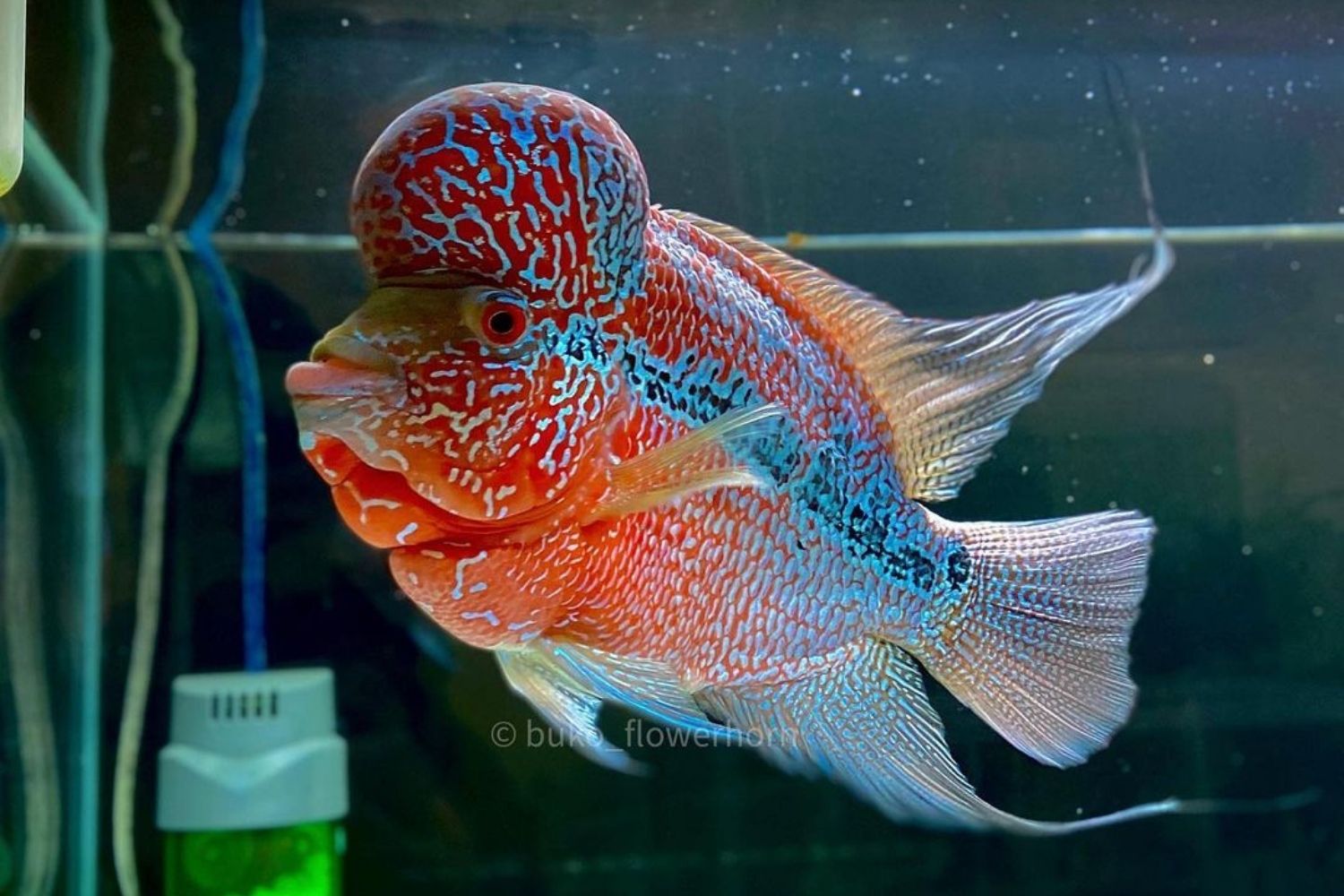The Flowerhorn Cichlid is a unique freshwater fish with a high reputation in the aquarist community. Their notable hump and bright colors will attract your attention immediately. If you love large and colorful fish, then you’ve found the right one.
This unique appearance comes from their special unnatural origin. Flowerhorn Cichlid was bred in Asia by crossing the Flower Horn Lou Han with some pearly American Cichlid.
Overview and Appearance
Flowerhorn Cichlid typically has a stretched body, which is tightened from the sides, even though some of their kind have rounded bodies looking like a disc. The most notable sign of the Flowerhorn Cichlid fish’s appearance is their silhouette, especially their attractive pectoral fines.
| Care Level | Intermediate |
| Family | Cichlidae |
| Size | Up to 16” (40 cm) |
| Color | Multi-color variants |
| Diet | Omnivore |
| Lifespan | 9 years |
| Temperament | Aggressive |
| Tank size | 75 Gallons |
When Flowerhorn Cichlid became popular in the aquarist community, it started to be bred in captivity. Being part of the Cichlid family, we can say that they would stay in the same conditions as other Cichlids. Known as highly territorial fish, we would not suggest keeping them with other fishes in the same aquarium.
Behavior and Temperament
Cichlids are, by their nature, aggressive fish to a certain degree, and Flowerhorn Cichlid is a member of the Cichlid family. Red Devil Cichlids, Jaguar Cichlid, and Jack Dempsey Cichlid are some of the more aggressive Cichlid, the bloodlines of which have many strains of the most beautiful Flowerhorn Cichlid.
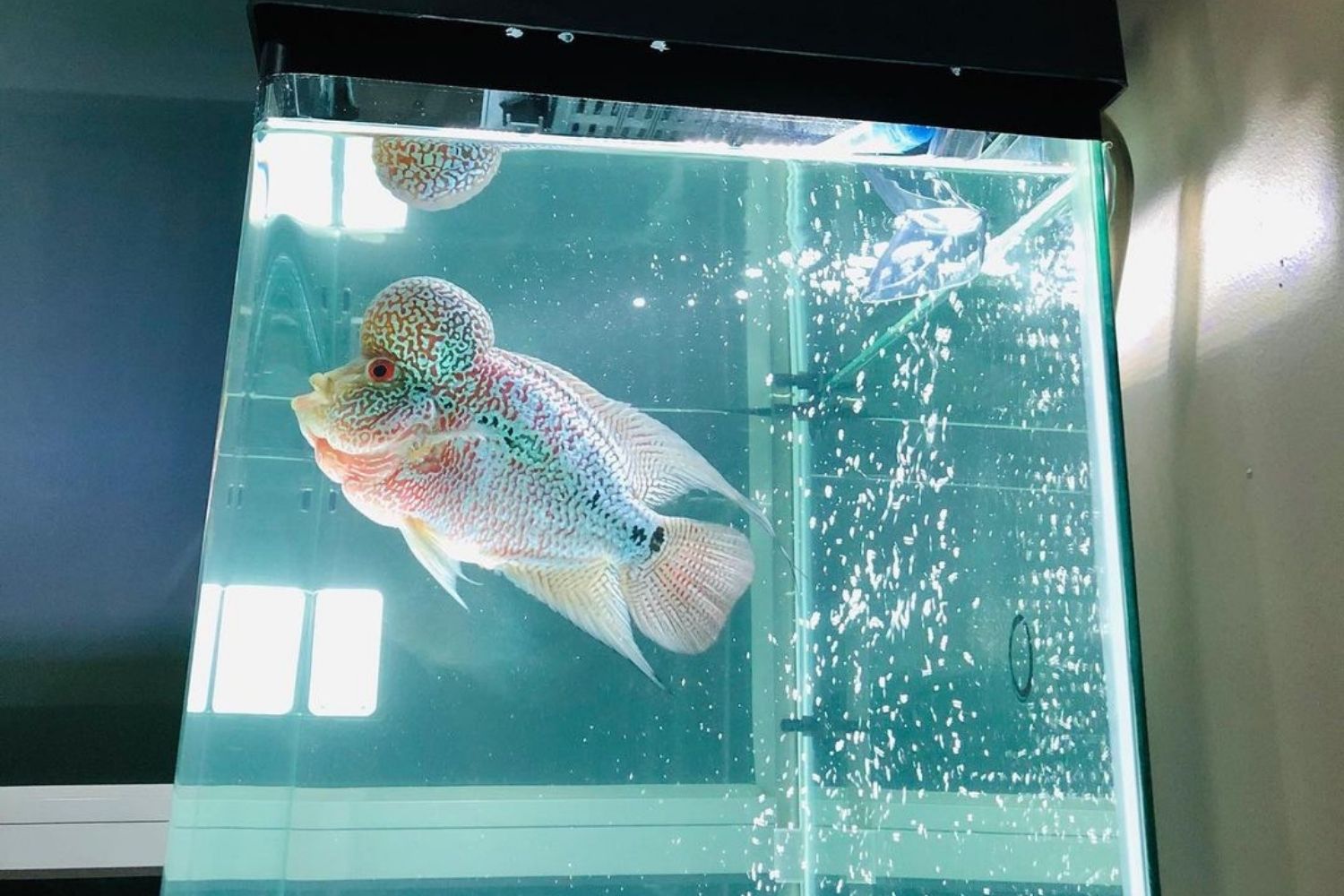
Flowerhorn Cichlid can be found in different colors.
Higher levels of aggression can result due to the intermingling of all the new and different strains caused by cross-breeding and further hybridization.
It is known that anything that seems to try to assert dominance over a Flowerhorn Cichlid will cause an aggressive attack, even though a Flowerhorn Cichlid can display aggression for no obvious reason at all. Spawning or protecting the eggs or fry from a spawn are other triggers for aggression in the Flowerhorn Cichlid.
A poorly maintained tank can make your Flowerhorn Cichlid uncomfortable and on edge. To keep your it happy and comfortable, feed them with adequate amounts and a variety of food.
Flowerhorn Cichlid wants to look around everything, while some fish always stay in the same area. Sometimes they’ll be near the surface. Other times you’ll see them checking out the substrate. That’s why adequate space is so important for this species.
Keeping them alone in a large tank is the best method for reducing Flowerhorn Cichlid aggression, or giving your other fish in the tank lots of places to hide is a wonderful solution. The method of “line of sight” works very well; out of sight, out of mind. There will be less aggression if the Flowerhorn Cichlid can’t readily see its tank mates. This protects your other stock from harm. Another good solution is setting up your large tank with lots of areas for different boundaries.
Origin
In the early 1990s, the Flowerhorn Cichlid fish came from Thailand, Malaysia, and Taiwan. Their family is the fish known as Cichlids. By breeding various varieties of Cichlids came the first known Flowerhorn Cichlid. To create the first one were crossed Blood Parrot, Red Devil, and Tri Mac Cichlid lines.
Flowerhorn cichlids would not exist at all if someone hadn’t come up with the idea to breed the different species of Cichlids. There are some Flowerhorn Cichlids in the wild areas in Thailand, Madagascar, parts of Africa, some in Malaysia, and some in Taiwan, which only exist outside a fish tank because they are cast off. Cichlids are also found near more tropical parts of America and India. Their care is like any other tropical fish.
The Flowerhorn Cichlid are freshwater-only fish. They would not survive for long in a saltwater environment.
Types of Flowerhorn Cichlid Fish
Rather than separate species, the types of Flowerhorn Cichlid are often considered morphs or color patterns. Here is a list of the most popular types. Even though there are hundreds of different Flowerhorn Cichlid strains and grades.
- KamFa – KamFa Flowerhorn cichlid is noted by their massive nuchal humpsand. They usually have red bodies and yellow eyes.
- Kamalau (Golden Monkey, or Kamfas) – The Kamalau Flowerhorns are one of the very few luohan-based Flowerhorns left in existence, and this is why they are considered lucky. They are similar to the Golden Based in colors, and most of them can have blue and gold pearling over a red or gold body.
- Chinese Zhen Zhu – These Flowerhorn is best known for their pearling, or line of flowering pattern along its body. Zhen Zhu Flowerhorns tend to be rounder with red eyes and yellow-tan in color.
- Thai Silk (Titanium FlowerHorn) – Titanium Flowerhorns, or Thai Silk Flowerhorns, have a metallic scale that covers their whole body. These Flowerhorns can appear in gold or white metallic morphs but usually are light blue in color.
- Gold Flowerhorn (Golden Base, Faders) – Gold Flowerhorn is like the marble-gene found in bettas, which is a gene that triggers random color changes throughout a betta’s body. These Flowerhorns are referred to as Faders because they start out with gold and red coloration, but as they mature, they turn black and then get back to a stronger gold and red coloration.
- Red Ingots/ King Kong Parrot – Red Parrot Flowerhorns are typically labeled as either Flowerhorns or specialized Blood Parrot Cichlid, depending on the body shape of this fish. If they have shorter bodies and lack a Kok are labeled as a King Kong Parrot cichlid, but still have strong red coloring and are considered “better” than the normal Blood Parrot.
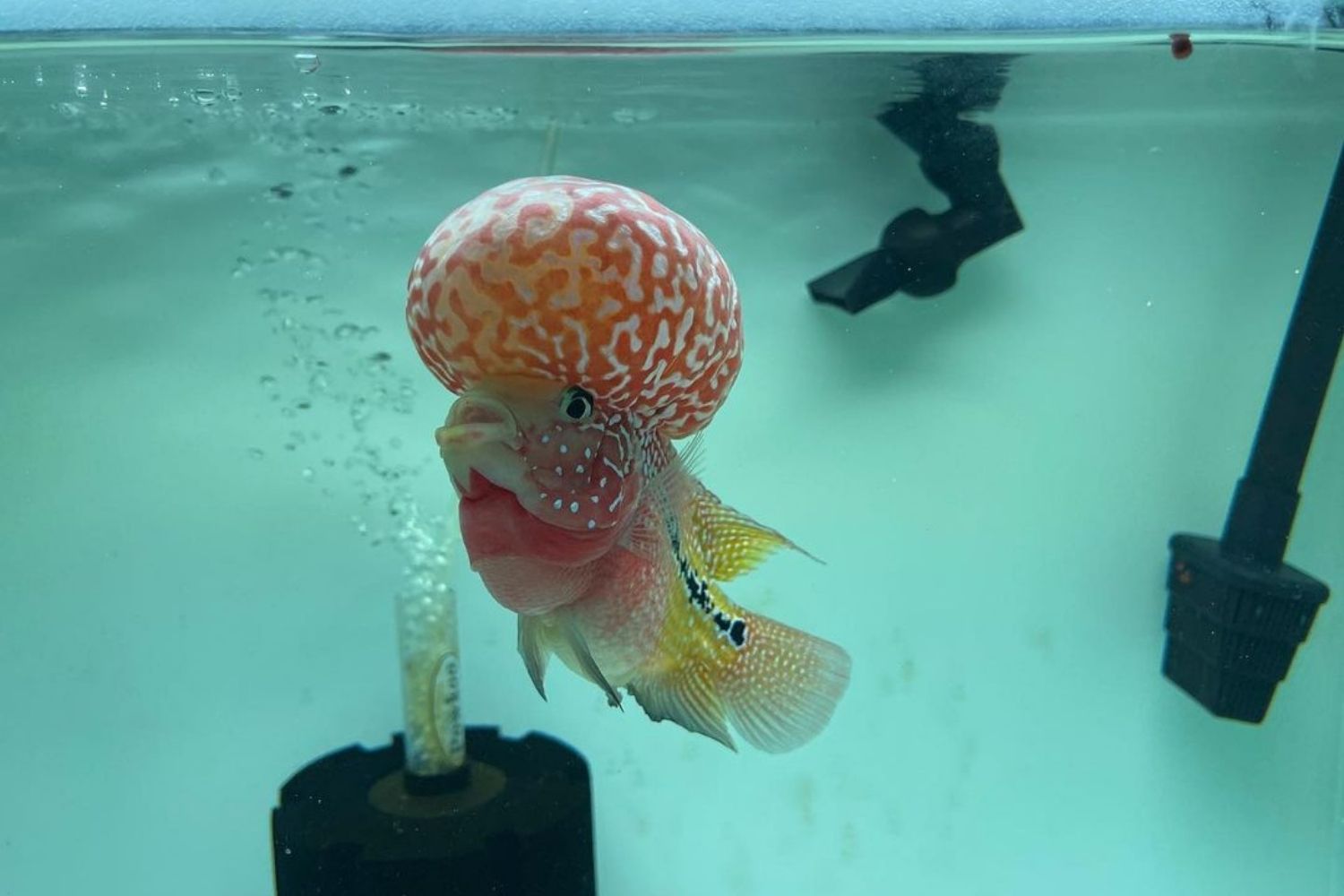
Flowerhorn Cichlid with an extremely big size.
Diet
When it comes to Flowerhorn Cichlid fish food, there are a lot of different options. It’s important to make sure they get enough protein, but also to provide some variety so you can give them a balanced diet. They will eat frozen and dried foods with no problems, so live food is not necessary.
They need high-quality protein sources such as:
- Bloodworms (white worms, blackworms, earthworms, nightcrawlers)
- Crickets
- Grasshoppers
- Worms
- Shrimp
The base of their diet should be some kind of plant-based food in order to provide your Flowerhorn Cichlid with the necessary nutrients. The common rule of thumb to follow is feeding them three times a day. You’ll likely need to reduce the quantity if it takes them longer than a minute to eat what you gave them.
Flowerhorn Cichlids are a fish that you need to avoid overfeeding since that can lead to excess ammonia, nitrite, and nitrate. These fish will love to eat whatever you put in their tank, so you need to make sure you’re giving them an appropriate amount of food on a daily basis.
Tank Requirements, Care and Maintenance
It’s common for Flowerhorn Cichlid to suffer from diseases such as a hole in the head and digestive blockages, so make sure to monitor your fish.
Tank Size
A tank size of 125 gallons (475 liters) or 150-175 gallons should be perfect for your Flowerhorn Cichlid if you want to keep a male and female pair. All fish appreciate more space, especially Flowerhorn Cichlid, even if some of the smaller strains can be kept in a 75 or 90-gallon.
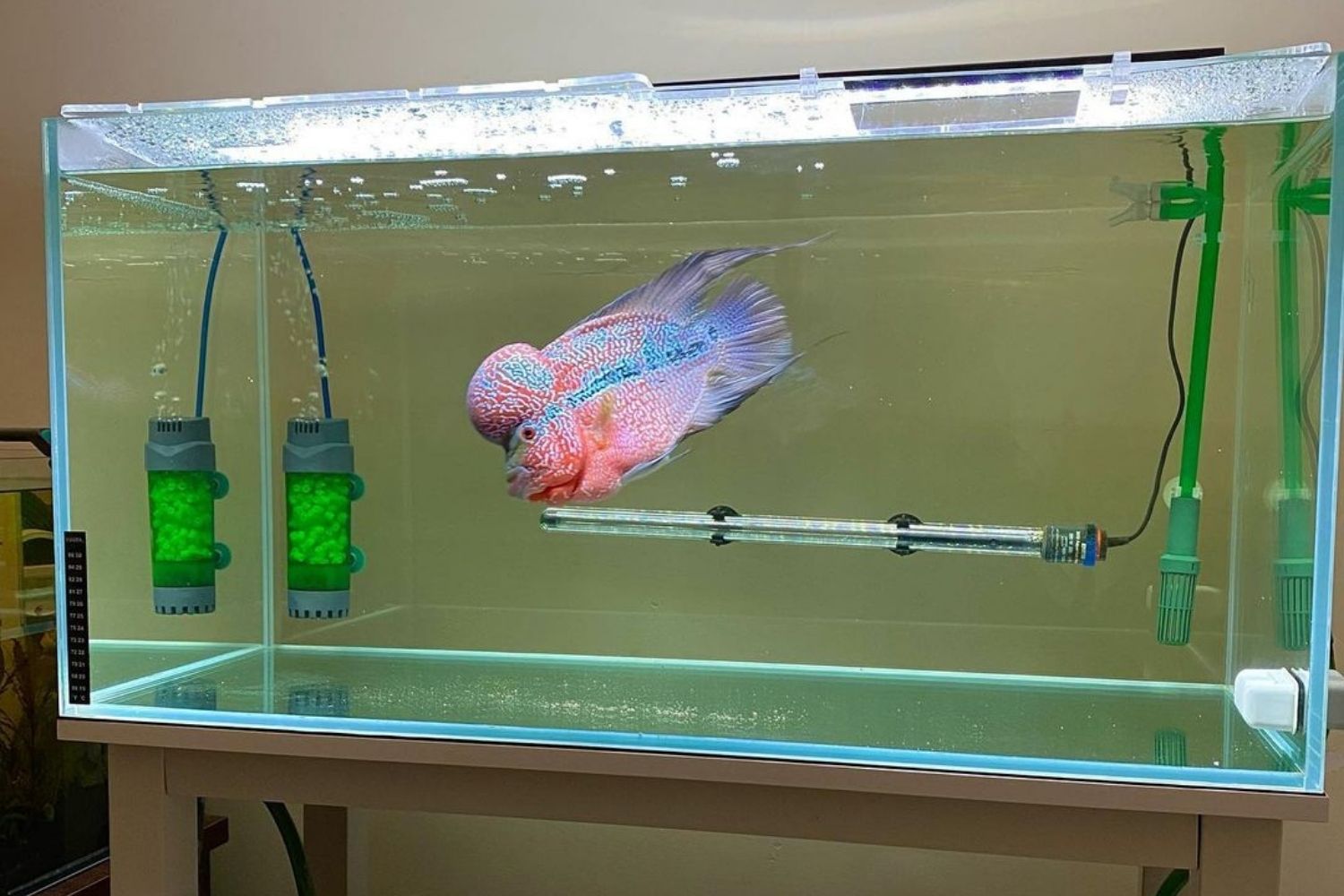
We keep Flowerhorn Cichlid in a 125 gallons tank.
Flow
Flowerhorn Cichlid can tolerate moderate to high flow, considered a strong fish, but if your fish is being blown all over the tank, the flow is too strong.
Substrate
Most large fish run the risk of swallowing it with their food if kept with a gravel substrate. The gravel can create a serious health risk if it is impacted in the fish’s intestines, preventing it from passing any waste. Some popular choices for Flowerhorn Cichlids are large pieces of tile, bare bottom, or sand substrates.
Water Parameters
The Flowerhorn Cichlid would not survive for long in saltwater, being the only freshwater environment fish. When it comes to Flowerhorn Cichlid care, maintaining the right water levels is essential. This is a great way to avoid many common diseases that come from low water quality. The mold of a standard tropical fish is the recommended parameter where Flowerhorn Cichlid can fit perfectly.
- Water temperature: 80°F to 86°F
- pH levels: 7-8 pH range
- Water hardness: 8-20 dGH
Perform regular water changes it are also necessary for your Flowerhorn Cichlid. This will help keep your fish healthy and deal with unwanted nitrates. More than other fish, Flowerhorn Cichlid is sensitive to ammonia, nitrite, and nitrates. Cycling the tank beforehand is essential because any measurable amount of ammonia or nitrite will actively cause damage to your fish.
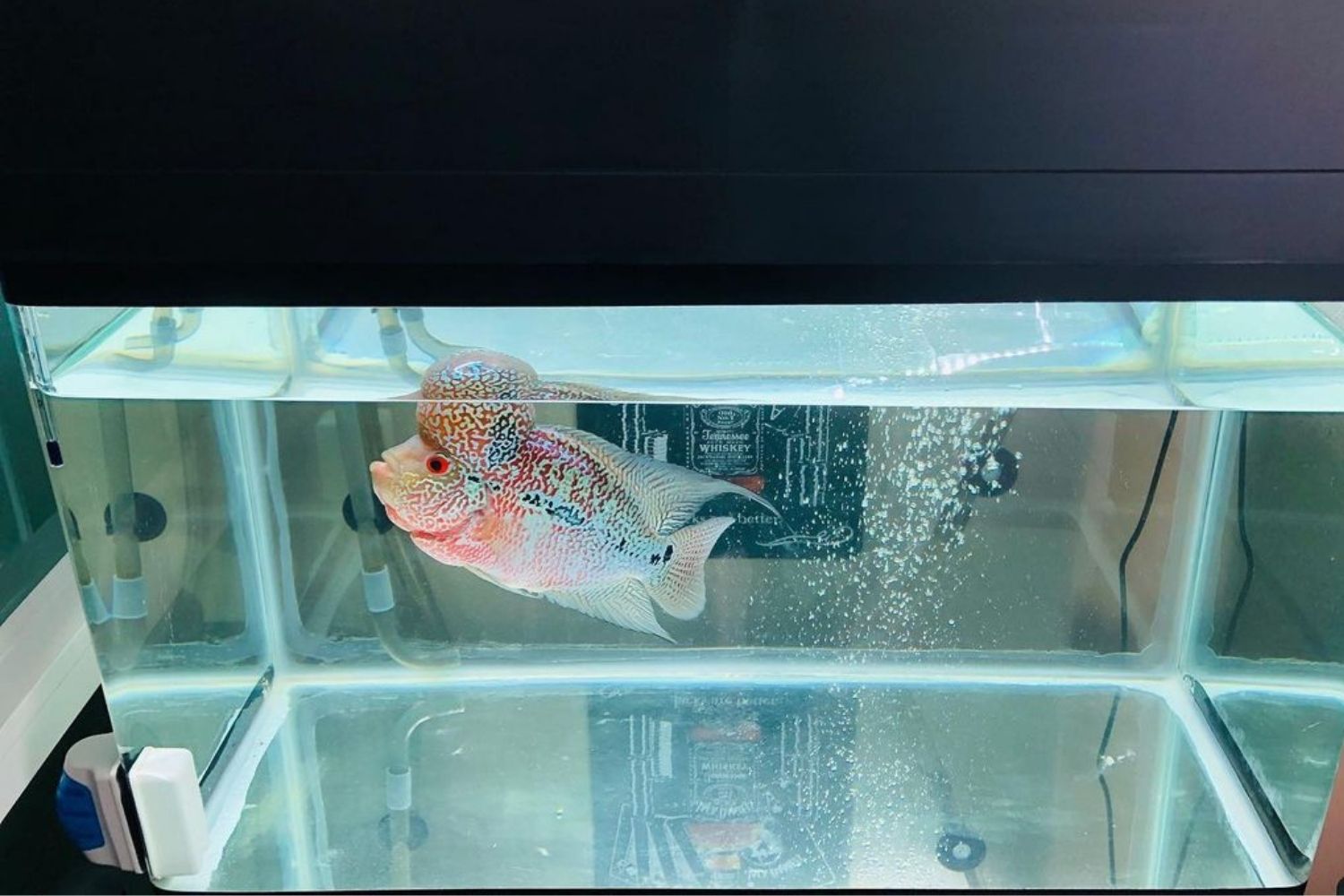
Keeping wrong water parameters can stress out or even cause death for Flowerhorn Cichlid.
Being a big-sized fish that loves to dig and root around the substrate means they can easily knock things around and unroot plants. For the likelihood of digging, the substrate in your tank should be soft to account for. Since that Flowerhorn Cichlid doesn’t have a lot of self-control, anything hard or sharp can lead to cuts on your fish.
Filtration
For large tanks, Canister Filters are the best option for crystal-clear water. Much more efficiently than smaller filters, they will be able to filter the large tank, such as Hang-on-Back (HOB) or sponge filters.
Lighting
You can pick specific LED lighting with adjustable colors if you want to show the Flowerhorn Cichlid’s best colors. Flowerhorn Cichlid doesn’t need much light, so when it comes to lighting, any aquarium light can be considered.
Heater
Flowehorn Cichlid needs a temperature of at least 80 degrees Fahrenheit, so a heater is essential for keeping them.
Breeding
Most of the Flowerhorn Cichlid is infertile since they are hybrid fish. Being able to breed a pair is going to be almost impossible. The males are far more likely to be infertile than the females. Finding a Cichlid that is likely to be in your Flowerhorn’s genetic history and breeding your Flowerhorn Cichlid to that cichlid is a more popular option.
Preparing a new bare bottom tank to store the tiny fries once they are ready to leave the parents’ nest is one of the most important things you can do. The small fries can get sucked into the filtration system, so do not install any filter mechanisms. For aeration purposes, an air stone is sufficient.
It will be good if an aquarium heater regulated to 82.4°F (28°C) can be placed in the aquarium. In order to keep the water quality in check, as breeding pairs do not consume much food during this period, the use of a mechanical filtration system is sufficient to remove any feces and debris. A fixed regime, until they are ready to spawn, is necessary to feed the breeding pair.
A new pair of fish is needed when you try to breed your Flowerhorn Cichlid, even though this is not easy because some pairs might not fit well together. Once you find a suitable pair of fish, put them in the same aquarium with a ‘’wall’’ in the middle to separate the two.
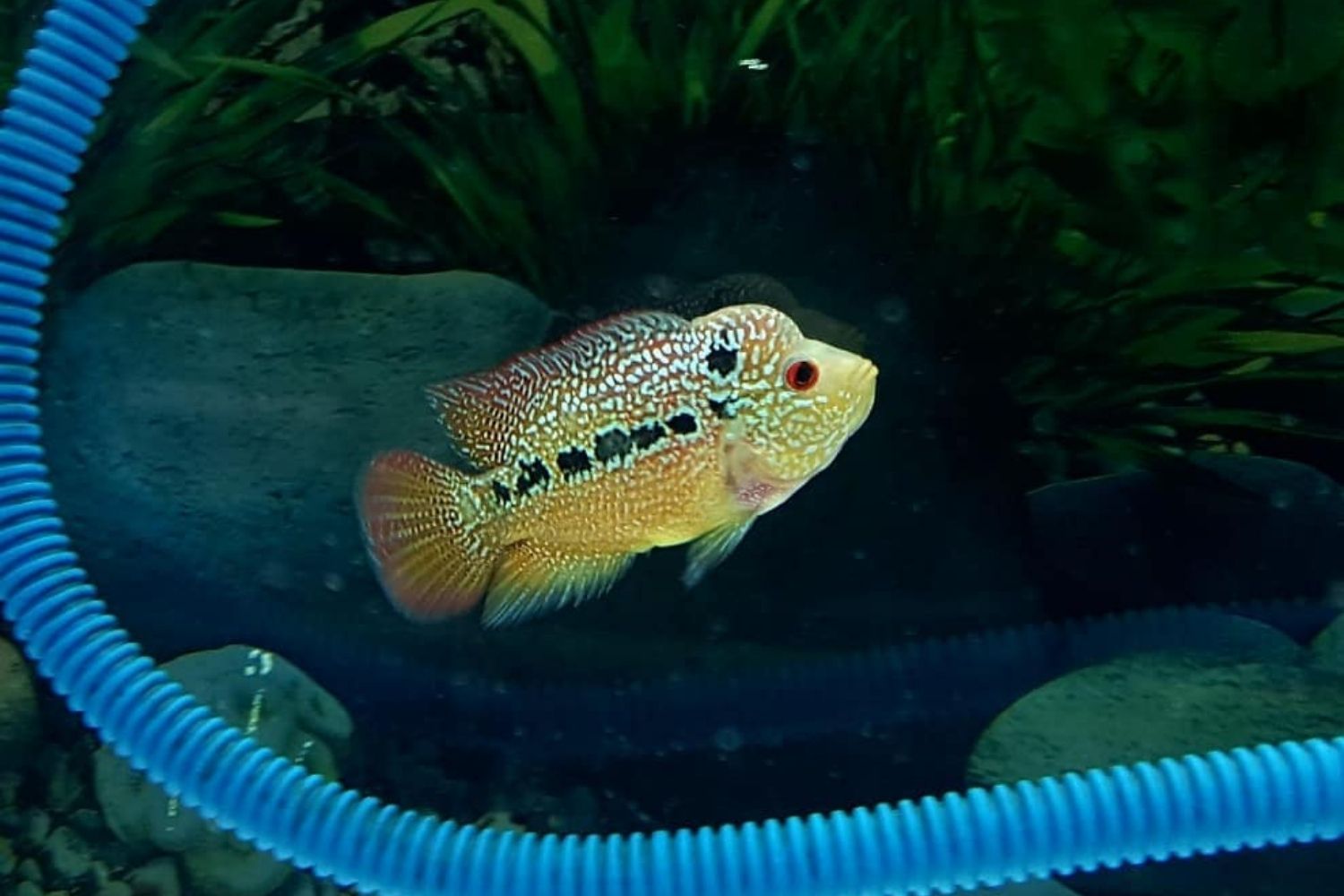
Flowerhorn Cichlid a few weeks after the hatch.
Hatching the eggs will take a few days and when this happens, remove the parents. Be sure to practice proper fry management once the parents are removed.
Sex Difference
Both sexes of the Flowerhorn Cichlid fish have flat, long bodies, with long dorsal and anal fins extending to the tip of their tails, with pectoral fins translucent and way shorter than their others.
One of the easiest ways to differentiate male Flowerhorn Cichlid cichlids from other fish is the hump on their forehead. Female Flowerhorn Cichlid doesn’t have any.
Male Flowerhorn Cichlid has more pronounced and vivid colors than females. Different from the male, the female Flowerhorn Cichlid has black spots on its dorsal fins, and the dorsal fin is quite short.
Unsuitable Tankmates
Any fish smaller than 10” (25 cm): A fish mate with peaceful nature will not survive the aggressive nature of a Flowerhorn Cichlid. Only keep them with other large cichlid species.
Invertebrates: Any shrimp, snail, or crayfish that will make it into their tank, Flowerhorn Cichlid will eat.
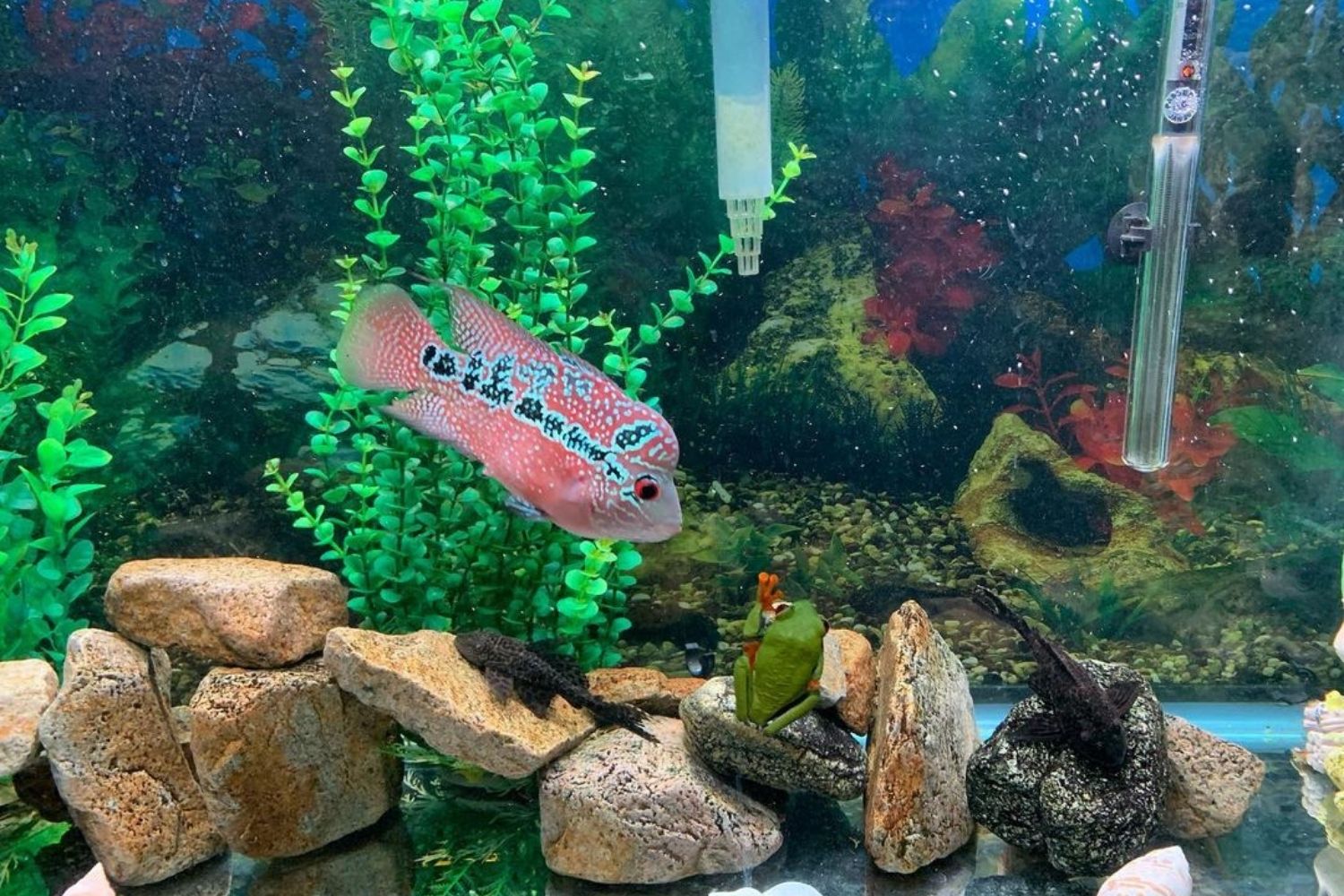
Flowerhorn Cichlid can be kept with other cichlid fish like Jaguar Cichlid.
